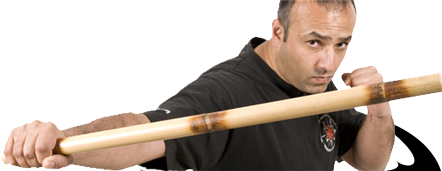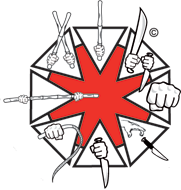Baraw – Knife
The Filipinos have developed knife training to a very high level, however most would recommend that if faced with a knife the best option is to run and the second option is to find an equaliser with the third option being to defend your self with empty hands, consequently knife training can be categorised into two areas with either a skilled or unskilled opponent being encountered in a confrontation;
- Offensive knife – fighting
- Knife defence
The first scenario we are going to analyse is offensive knife fighting in which both you and your opponent have a knife, you are skilled and the opponent is unskilled.
- Limb destruction
- follow up thrusts
- Use of live hand
The next scenario would be knife versus empty hands with you been skilled with the knife and the opponent is unskilled with the empty hands.
- Against the jab
- Against the cross
- Against the hook
- Against high kicks
The next scenario would be knife versus knife with both you and the opponent being skilled which is essentially scientific knife fighting. In order to not get killed or severely injured you need to exhibit the following characteristics.
- Tight – Quick retracting attack
- Keep knife central
- Mobile footwork
- Effective feinting
The last scenario when you and your opponent are skilled but must defend with empty hands which is the worst case scenario in this situation you must employ the following tactics.
- Hands in tight
- Feints
- Disarms
The next block of material will look at scenarios were your opponent delivers a committed stab, this may occur in two possible ways, the first being when the opponent grabs some part of your body and the other is when he attacks without grabbing.
- Wrist grab and stab
- Throat grab and stab
- Neck grab and stab
- Angle 1 stab – V lock
- Angle 2 stab – figure four lock
- Angle 5 stab – reverse figure four eagle wing block
- Angle 6 slash – double rear arm bar
In addition to disarming and locking it is important to be able strangle/choke your opponent , however most clothing based and naked chokes are considered dangerous against the knife, the Filipinos only use the following three chokes against a knife attack
- Side strangle
- Frontal strangle
- Rear choke arm bar.
Knife flow drills are also taught to help develop attributes such as reflexes, hand eye coordination, and sensitivity.
- Palasut
- Agak
- Pit – Al
- Tapi – Tapi
The Filipino martial arts are regarded as been among the most practical systems for edge-weapons defence and have developed edged-weapons training to a very high scientific level, however most would recommend that if faced with a knife the best option is to run and the second option is to find an equaliser with the third option being to defend your self with empty hands.
The characteristics of the weapon make it a very dangerous tool to defend and to have any hope in dealing with such a deadly weapon you need to acquire the right mindset, awareness, and appropriate set of skills. Training drills, designed specifically to deal with the characteristics of the knife are used to install the appropriate and correct response while understanding the journey.
This is done through reactionary, reflexive and conditioned responses which give an in-depth understanding of the mental interpretation of what’s happening within an unconscious response along with a developed and trained response which still may not be correct which then all lead to the final correct response.
The progressive and structured techniques taught to deal with none linear or committed attack progress firstly through attributes such as tactile sensitivity developed through pit-al followed by counter for counter attack and defence which include disarms, locks, arm wrenches, chokes and strangles but to name a few.
Despite the horror, tragedy and outcome of a real-life knife attack, practitioners often find knife drills a highly enjoyable activity that combine high-speed reactions, survival skills, deceptiveness with the potential danger of a knife but the actuality of a safe training dagger, consequently the acquired skills developed from edged-weapons directly translate to empty hand along with the speed, agility and a great sense of urgency created during edged weapon training.


